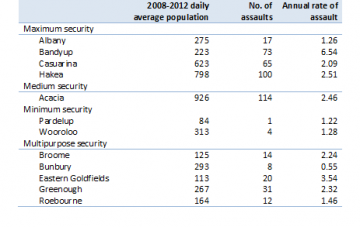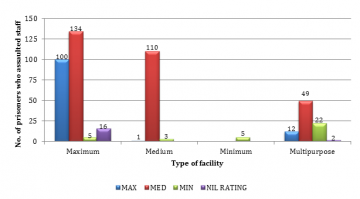In response to a rapid growth in prisoner numbers from 2009, the government invested heavily in additional prison capacity, primarily for men. There has been investment at all security levels, but especially at the three male maximum security facilities, Albany, Casuarina and Hakea prisons. As a result, the state now has more than 2,500 maximum security beds for fewer than 500 maximum security prisoners. Inevitably, there has been a large increase in prisoners being placed at more secure facilities than their security classification dictates. Assault rates vary widely between facilities:
Table: Number and rate of staff assaults by custodial facility
Assault rates at minimum security facilities are appropriately low. There are four ‘pure’ minimum security prisons in Western Australia; Karnet, Pardelup and Wooroloo prison farms and Boronia Pre-release Centre for Women. Prisoners placed at these facilities require a low level of supervision and control within the prison and they can be reasonably trusted in open conditions. Only one assault was recorded at Pardelup (October 2010) and Wooroloo recorded just one assault each year except in 2011. No staff assaults were recorded at either Karnet or Boronia.
Acacia Prison is the only facility classified as medium security throughout. It holds minimum security prisoners in addition to those classified as medium security. It cannot permanently house maximum security prisoners, however occasionally it temporarily holds people rated maximum. Acacia is the largest prison in the state with a daily average population of 926 prisoners for the five year period. It had the highest number of assaults of any prison and approximately a quarter of all staff assaults occurred there. However, Acacia’s annual rate of staff assault compared to its prisoner population (2.46 assaults per 100 prisoners) was lower than the annual rate at Bandyup, Eastern Goldfields, and Hakea prisons. There was one assault by a maximum security prisoner at Acacia, and three by minimum security prisoners.
Four prisons – Albany, Bandyup, Hakea and Casuarina – are classified as maximum security facilities due to their design, philosophy and operational procedures. Together they accounted for 56 per cent of staff assault incidents (255). Prisoners held in these facilities can have various security ratings. Out of the 255 prisoners who assaulted staff in maximum security prisons, 100 were maximum security, 134 medium and 5 minimum. Another 16 did not have classifications.
The rate of staff assault at Bandyup Women’s Prison was by far the highest in the state. It was two and half to three times higher than the rate at the two large male maximum security facilities, Hakea and Casuarina. Alarmingly, by the end of 2013 Bandyup Women’s Prison had amassed 40 assaults for the year, more than double the number of assaults in 2012. This was vastly higher than any other facility with Hakea recording the next highest count (22) followed by Acacia (20).
The remaining prisons – all of which are regional – are best described as multipurpose. They accommodate prisoners with all types of security ratings. For example, Bunbury Regional Prison is predominantly medium security with a number of maximum security beds. However, it also has a ‘Pre-release Unit’ accommodating approximately 100 minimum security prisoners. There were 85 staff assaults at multipurpose prisons, the vast majority of which were committed by medium security prisoners (57.6%).
Figure: Breakdown of prisoner security ratings by prison security types
As shown, prisoners rated minimum security assaulted staff far more frequently when placed in a maximum or multipurpose facility than when placed at minimum security. Almost three quarters of assaults (73.3%) by minimum security prisoners occurred in multipurpose facilities, despite less than 30 per cent of minimum security prisoners being located in these facilities. In addition, the same number of minimum security prisoners assaulted staff in maximum security facilities as in minimum security facilities, despite there being three times as many minimum security prisoners at minimum security facilities.
There are sometimes legitimate reasons why prisoners are placed in facilities where the security rating is higher than their own. This might be to maintain familial contact and visiting arrangements, or to undertake programs not offered at other prisons. However, there are occasions when people are accommodated in a facility with a higher security rating than their own simply because there is insufficient room in the system to accommodate people in an appropriate facility.
In the 2012 report The flow of prisoners to minimum security, section 95 and work camps in Western Australia, this Office found too many prisoners were being held at higher security levels than their ratings required. A massive number of minimum security prisoners are being held at maximum and medium security prisons, with no regime differentiation. Similarly, there are many medium security prisoners being held in maximum security facilities.
The extent of detention in over-secure facilities has been even more marked in the female estate. In 2009, Bandyup held around the same number of maximum as minimum security prisoners. However, in 2012, it held 3.5 times more minimum security women than maximum security. Almost one in four women held at Bandyup were rated as minimum security, a figure far in excess of any of the male prisons. The numbers at Bandyup were equivalent to the total design capacity of Boronia, the state’s only dedicated female minimum security facility.
The 2012 review concluded that the Department should reduce the number of prisoners subjected to levels of security that are unnecessary given their security ratings. The correlation between housing people in over-secure facilities and the rate of staff assault gives added weight to this conclusion. In 2012 the Department committed to action but the situation continues to be of concern.

